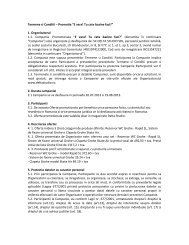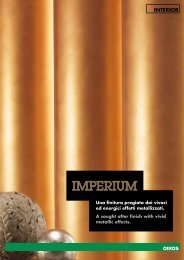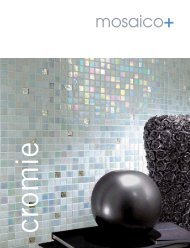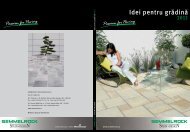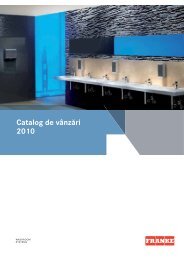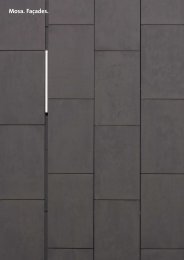series urbatek - Delta Studio
series urbatek - Delta Studio
series urbatek - Delta Studio
Create successful ePaper yourself
Turn your PDF publications into a flip-book with our unique Google optimized e-Paper software.
244<br />
CORTES EN GRES PORCELÁNICO TÉCNICO / TECHNICAL PORCELAIN CUTS<br />
PERFORACIÓN EN GRES PORCELÁNICO TÉCNICO / TECHNICAL PORCELAIN DRILLING<br />
INFORMACIÓN TÉCNICA<br />
<br />
producto cerámico a la geometría de la zona.<br />
<br />
empleo de una técnica de perforación correcta.<br />
TIPOS DE CORTE<br />
HERRAMIENTAS<br />
Corte lineal y diagonal: Se realiza para rematar el perímetro del local o bien<br />
<br />
<br />
<br />
HERRAMIENTAS DE CORTE:<br />
En el mercado existe una amplia gama de herramientas que nos permiten un<br />
<br />
Taladro: Es necesario que tenga una potencia mayor o igual a 600W. selector de modo NO PERCUTOR (rotación), selector de velocidades.<br />
Brocas:<br />
Broca de carburo de tungsteno especial porcelánico:<br />
-Extremo helicoidal especial.<br />
<br />
<br />
Broca de diamante:<br />
-Extremo cilíndrico<br />
-Extremo corona<br />
Corte Manual: La máquina debe tener las características adecuadas para<br />
los formatos, grosores de piezas y trabajos a realizar. En relación al tamaño<br />
del rodel, es recomendable emplear un diámetro de 8 mm para piezas con<br />
<br />
Corte eléctrico: Está provista de un disco de diamante y sistema de<br />
refrigeración con agua. Nos permite realizar cortes precisos y de cierta<br />
complejidad, sobre materiales muy duros. Debe tener las características<br />
adecuadas para los formatos, grosores de pieza y trabajos a realizar.<br />
El disco de diamante debe ser de corte en húmedo y de banda continua.<br />
Esta herramienta es la más idónea para realizar cualquier tipo de corte en el<br />
porcelánico.<br />
Amoladora: Está provista de un disco de diamante.<br />
Se recomienda el empleo de una amoladora de baja potencia, de 600-1100W<br />
aprox., que utiliza disco de diámetro 115 o 125mm.<br />
El disco de diamante debe ser de corte en seco y de banda continua.<br />
TÉCNICAS DE PERFORACIÓN<br />
Grandes Perforaciones (Diámetro mayor o igual a 15 mm.):<br />
1.- Marcar el punto de perforación. Previamente se comprobará que no existe ninguna conducción o línea de cableado (se puede usar detector).<br />
2.- Fija broca (taladro potencia superior a 600W).<br />
3.- Colocar en modo NO percutor.<br />
4.- Refrigerar en modo continuo, con agua el punto de perforación.<br />
<br />
Pequeñas perforaciones (Diámetro menor a 15 mm.):<br />
1.- Marcar el punto de perforación. Previamente se comprobará que no existe ninguna conducción o línea de cableado (se puede usar detector).<br />
2.- Fija broca (taladro potencia superior a 600W).<br />
3.- Emplear sistema de centrado: usar velocidad lenta menor a 1000 rpm.<br />
4.- Colocar en modo NO percutor.<br />
5.- Refrigerar en modo continuo, con agua el punto de perforación.<br />
6.- Es recomendable realizar una perforación previa con una broca de menor diámetro (5 o 6 mm.) y posteriormente usar el deseado.<br />
<br />
<br />
<br />
<br />
<br />
Linear and diagonal cuts: Used for the perimeter of the area or to run the tiles<br />
<br />
<br />
selector.<br />
<br />
columns, doorframes, plug sockets, drains, etc.<br />
<br />
<br />
effectively cut Urbatek porcelain tiles.<br />
Bits:<br />
Special tungsten carbide bit for porcelain tiles:<br />
-Special spiral tip.<br />
<br />
<br />
Diamond-tipped bit:<br />
-Cylindrical tip<br />
-Crown tip<br />
<br />
<br />
a diameter of 8 mm for tiles with a smooth surface, and 18 mm for tiles with a<br />
rough surface.<br />
Electrical cutting: Using a diamond cutting disc and water-cooling system, to<br />
make precise, complex cuts on very hard materials. Must have the necessary<br />
features for the formats, thicknesses and type of work to be carried out.<br />
<br />
<br />
Grinder: Uses a diamond disc.<br />
<br />
using a 115 or 125 mm diameter disc.<br />
<br />
<br />
Drilling large holes (with a diameter of 15 mm or more):<br />
1.- Mark the drilling point, checking beforehand that there are no power cables or pipes below (using a detector if required).<br />
<br />
3.- Use in normal, non-percussive mode.<br />
4.- Cool the drilling point constantly using water.<br />
6.- Once the bit has drilled through the tile, change the bit to extend its useful working life.<br />
Drilling small holes (with a diameter of less than 15 mm):<br />
1.- Mark the drilling point, checking beforehand that there are no power cables or pipes below (using a detector if required).<br />
<br />
3.- Use the centring system, at a slow speed of less than 1000 rpm.<br />
4.- Use in normal, non-percussive mode.<br />
5.- Cool the drilling point constantly using water.<br />
<br />
7.- Once the bit has drilled through the tile, change the bit to extend its useful working life.




